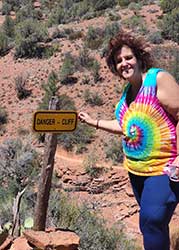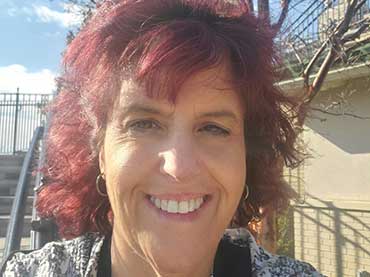Meet Amy Paszkowski
It was a seemingly normal Wednesday in the summer of 2021. Amy Paszkowski was dog sitting for a friend when her quality time with the pup took a surprising turn.
“I got bit on the nose and lips,” Amy recalls. “It was quite the emotional experience.”
That Friday, she underwent plastic surgery, where skin was removed from behind her right ear and placed on her nose. Her bandages were removed a week later.
“I’m not someone who is overly concerned about appearance,” Amy explains. “I didn’t really care about possibly having a scar and just wanted to move on with my life, but when I learned about a treatment at UPMC, I knew it was something I should explore.”
Exploring Hyperbaric Oxygen Therapy
Because Amy had what was determined to be a potentially compromised skin graft, she qualified for hyperbaric oxygen therapy (HBOT), which delivers a greater-than-normal amount of oxygen to a patient’s body tissues to stimulate growth factors and stem cells, ultimately strengthening the body’s natural wound-healing process.
Amy soon met with Marc Mancinelli, DO from UPMC Wound Healing Services at UPMC Hamot, and he provided her with details about what to expect from HBOT.
“This type of therapy is so fascinating, but Dr. Mancinelli told me it would be a big commitment,” Amy says. “I knew a little bit about it from advertisements on TV but didn’t understand all of the details down to the cellular, molecular level.”
As part of HBOT, patients lie in a specialized bed housed within a spacious, clear chamber. Pressure in the chamber is slowly increased, creating an effect similar to a diver going deep under water. Patients “resurface” near the end of the “dive” as the chamber is slowly depressurized.
Amy was thankful that her care team did such a great job preparing her for the treatment
“They explained everything I needed to know about what to expect and went over every item on the checklist twice during each visit. I never felt alone while in the chamber, and if I needed anything, it was a comfort to know my team was right there with me.”
And one of the HBOT technicians was especially attentive.
“I would bring a CD in with me to listen to during the dive, but it always ended before I was done. I could have tapped on the glass to ask the nurse to restart it, but she timed it out and knew when to restart the music so I could just keep my eyes closed and continue to relax.”
The Road to Recovery
 Overall, Amy went through 16 HBOT sessions over the course of four weeks, with each one ranging from 90-100 minutes.
Overall, Amy went through 16 HBOT sessions over the course of four weeks, with each one ranging from 90-100 minutes.
The end result was an appearance she didn’t envision after that fateful day with a dog.
“There’s no doubt in my mind that thanks to HBOT, the healing of my wound was put on a much faster timeline,” Amy recalls.
A registered nurse herself, Amy admits to being a “tough critic” with “high standards” when it comes to patient care, but she says that UPMC exceeded expectations.
“The whole team – from the receptionists to the nurses to Dr. Mancinelli – they knew me and treated me like someone who had been coming to see them for years. They celebrated my successes and provided encouragement along the way.”
Amy’s treatment and results may not be representative of all similar cases.

















